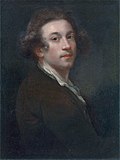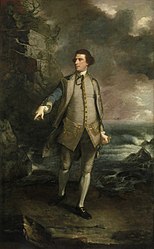File:Captain the Honourable Augustus Keppel, 1725-86 RMG L6608-002.jpg

Original file (947 × 1,280 pixels, file size: 708 KB, MIME type: image/jpeg)
Captions
Captions
Summary
[edit]| Joshua Reynolds: Captain the Honourable Augustus Keppel, 1725-86
|
||||||||||||||||||||||
|---|---|---|---|---|---|---|---|---|---|---|---|---|---|---|---|---|---|---|---|---|---|---|
| Artist |
artist QS:P170,Q194402 |
|||||||||||||||||||||
| Title | ||||||||||||||||||||||
| Object type |
painting object_type QS:P31,Q3305213 |
|||||||||||||||||||||
| Genre |
portrait |
|||||||||||||||||||||
| Description |
English: Captain the Honourable Augustus Keppel, 1725-86 A full-length portrait slightly to right facing to left, wearing a version of captain's undress uniform (1748-67), with grey breeches, waistcoat and facings, double lacing on the waistcoat pockets and slightly striped stockings. Naval historians draw attention in this portrait to the wearing of the new regular uniform made compulsory by an order dated 14 April 1748. However, this took some while to be implemented and what is shown here is idiosyncratic in design and colour, for whatever reason. Keppel was the second son of the Earl of Albemarle, and one of a powerful Whig family who came to England in 1688 with William III. In 1740 he joined Commodore Anson on his four-year voyage round the world in the 'Centurion'. In 1749 he went as commodore to the Mediterranean, and took Joshua Reynolds with him (again in the 'Centurion'). This voyage marked the beginning of a close lifelong friendship between them. Reynolds was en route for Italy, where he stayed for two years. In 1758 Keppel commanded a small expedition, which captured the island fortress of Goree, off Dakar on the West African coast. At the Battle of Quiberon Bay, 20 November 1759, he commanded the 'Torbay', 74 guns, and played a notable part by sinking the French 'Thesée', 74 guns. In 1761 he commanded the naval forces at the capture of Belle Ile and in the following year was second-in-command to Sir George Pocock at the capture of Havana. During this time he became a rear-admiral. On this expedition his elder brother, Lord Albemarle, was Commander-in-Chief and another brother was a general officer on his staff. Keppel commanded the Channel fleet in the early years of the American War of Independence, 1775-83, but found the fleet unprepared. On 27 July 1778 in the 'Victory', 100 guns, he led the fleet in an indecisive battle with the French off Ushant. His second-in-command, Sir Hugh Palliser, gave him inadequate support and the resulting quarrel split the Navy. Keppel, a Whig, was tried by court-martial, at which Palliser, a Tory, conducted the prosecution. When Keppel was acquitted he became the hero of the hour but the whole affair was politically charged. Keppel retired from active service, entered Parliament as MP for Surrey, and became a Viscount in 1782. Painted as a tribute to Keppel in 1752-53, on Reynolds's return from Europe, this picture made the artist's name in London and it remained in his studio for years where his patrons could see it. Observers noted that he had taken great pains with the composition, repeatedly scraping off paint to make changes, a situation confirmed by modern X-ray examination. The portrait, for which there were many sittings, attracted public notice and a contemporary account claimed that it established Reynolds as the 'greatest painter that England had seen since Van Dyck'. Its painting was important for Reynolds because he was hoping to attract distinguished patrons and advance his own career by portraying a rising star, who also wished to advance himself. Keppel, as befits one of the most highly regarded of England's young naval commanders at the time, strides on a beach in a pose stylistically adopted by 18th-century portrait painters to elevate the status of their sitters. Reynolds has variously been thought to have been inspired either by the classical statue, the Apollo Belvedere (which he would have seen in Rome), or, more recently, by a 17th-century statue of Apollo related to this but by the French sculptor Pierre Legros (1666-1719). The background of tempestuous sea , stormy shore and wreckage in the waves, anticipates the Romantic movement. The dramatic lighting and striding figure equally indicate a Venetian influence and the choice of setting may allude to the loss of Keppel's ship, the 'Maidstone', 50 guns, wrecked off Brittany in 1747. That the background was a case of 'second thoughts' is proved by the fact that the cliff on the left is painted over a more conventional earlier design of a classical column on a raised base. In 1740, Reynolds was apprenticed to the portrait painter Thomas Hudson (1701-90) and he travelled to Italy in 1749. In 1753 he set up in London and rapidly made a name as a portrait painter, profoundly influenced by his time in Italy to travel and study. Reynolds borrowed poses from the old masters and by 1759 had created social portraits in a new style that were deemed fresh and modern and yet dignified the status of the sitter. He became the first President of the Royal Academy in 1768 and was knighted the following year. Reynolds was the leading portrait painter of his day and the most influential figure of the century in elevating the status of British painting and portraiture. His conscious pursuit of an imagery of public virtue is anchored in 'grand style' historical art supported by a body of aesthetic theory deeply imbued with civic humanist values. |
|||||||||||||||||||||
| Depicted people |
Augustus Keppel, 1st Viscount Keppel |
|||||||||||||||||||||
| Date | 1752 | |||||||||||||||||||||
| Medium |
oil on canvas |
|||||||||||||||||||||
| Dimensions | Frame: 2702 mm x 1795 mm x 115 mm;Overall: 125 kg;Painting: 2390 x 1475 mm | |||||||||||||||||||||
| Collection |
institution QS:P195,Q7374509 |
|||||||||||||||||||||
| Current location | ||||||||||||||||||||||
| Accession number |
BHC2823 |
|||||||||||||||||||||
| Notes | Depiction association: full length. This object was sighted as being on display during the Collections Inventory Project (2001-2005). It will need to be checked for object numbers and its condition activity updated. | |||||||||||||||||||||
| References | ||||||||||||||||||||||
| Source/Photographer | http://collections.rmg.co.uk/collections/objects/14296 | |||||||||||||||||||||
| Permission (Reusing this file) |
The original artefact or artwork has been assessed as public domain by age, and faithful reproductions of the two dimensional work are also public domain. No permission is required for reuse for any purpose. The text of this image record has been derived from the Royal Museums Greenwich catalogue and image metadata. Individual data and facts such as date, author and title are not copyrightable, but reuse of longer descriptive text from the catalogue may not be considered fair use. Reuse of the text must be attributed to the "National Maritime Museum, Greenwich, London" and a Creative Commons CC-BY-NC-SA-3.0 license may apply if not rewritten. Refer to Royal Museums Greenwich copyright. |
|||||||||||||||||||||
| Other versions |
|
|||||||||||||||||||||
| Identifier InfoField | Acquisition Number: 1939-1757 id number: BHC2823 |
|||||||||||||||||||||
| Collection InfoField | Oil paintings | |||||||||||||||||||||
Licensing
[edit]|
This is a faithful photographic reproduction of a two-dimensional, public domain work of art. The work of art itself is in the public domain for the following reason:
The official position taken by the Wikimedia Foundation is that "faithful reproductions of two-dimensional public domain works of art are public domain".
This photographic reproduction is therefore also considered to be in the public domain in the United States. In other jurisdictions, re-use of this content may be restricted; see Reuse of PD-Art photographs for details. | |||||
File history
Click on a date/time to view the file as it appeared at that time.
| Date/Time | Thumbnail | Dimensions | User | Comment | |
|---|---|---|---|---|---|
| current | 15:05, 30 September 2017 |  | 947 × 1,280 (708 KB) | Fæ (talk | contribs) | Royal Museums Greenwich Oil paintings (1752), http://collections.rmg.co.uk/collections/objects/14296 #1869-12 |
You cannot overwrite this file.
File usage on Commons
The following 15 pages use this file:
- User:Fæ/Project list/RMG
- File:Captain the Honourable Augustus Keppel, 1725-86 RMG BHC2823.tiff
- File:Captain the Honourable Augustus Keppel, 1725-86 RMG L6606.tiff
- File:Captain the Honourable Augustus Keppel, 1725-86 RMG L6607-001.tiff
- File:Captain the Honourable Augustus Keppel, 1725-86 RMG L6607-002.tiff
- File:Captain the Honourable Augustus Keppel, 1725-86 RMG L6607-003.tiff
- File:Captain the Honourable Augustus Keppel, 1725-86 RMG L6607-004.tiff
- File:Captain the Honourable Augustus Keppel, 1725-86 RMG L6607-005.tiff
- File:Captain the Honourable Augustus Keppel, 1725-86 RMG L6607-006.tiff
- File:Captain the Honourable Augustus Keppel, 1725-86 RMG L6607-007.tiff
- File:Captain the Honourable Augustus Keppel, 1725-86 RMG L6607-008.tiff
- File:Captain the Honourable Augustus Keppel, 1725-86 RMG L6607-009.tiff
- File:Captain the Honourable Augustus Keppel, 1725-86 RMG L6608-001.tiff
- File:Captain the Honourable Augustus Keppel, 1725-86 RMG L6608-002.jpg
- File:Captain the Honourable Augustus Keppel, 1725-86 RMG L6654.tiff
Metadata
This file contains additional information such as Exif metadata which may have been added by the digital camera, scanner, or software program used to create or digitize it. If the file has been modified from its original state, some details such as the timestamp may not fully reflect those of the original file. The timestamp is only as accurate as the clock in the camera, and it may be completely wrong.
| Image title |
|
|---|---|
| Author | Tina Warner |
| Short title |
|
| Copyright holder |
|
| Width | 6,662 px |
| Height | 9,000 px |
| Bits per component |
|
| Compression scheme | Uncompressed |
| Pixel composition | RGB |
| Orientation | Normal |
| Number of components | 3 |
| Horizontal resolution | 72 dpi |
| Vertical resolution | 72 dpi |
| Data arrangement | chunky format |
| Software used | Adobe Photoshop CS5.1 Macintosh |
| File change date and time | 13:46, 9 December 2013 |
| Color space | sRGB |
| Date and time of digitizing | 14:24, 6 December 2013 |
| Date metadata was last modified | 13:46, 9 December 2013 |
| Unique ID of original document | xmp.did:22FD1B1D1F20681192B0B818AF5F0CF8 |
| Copyright status | Copyrighted |















